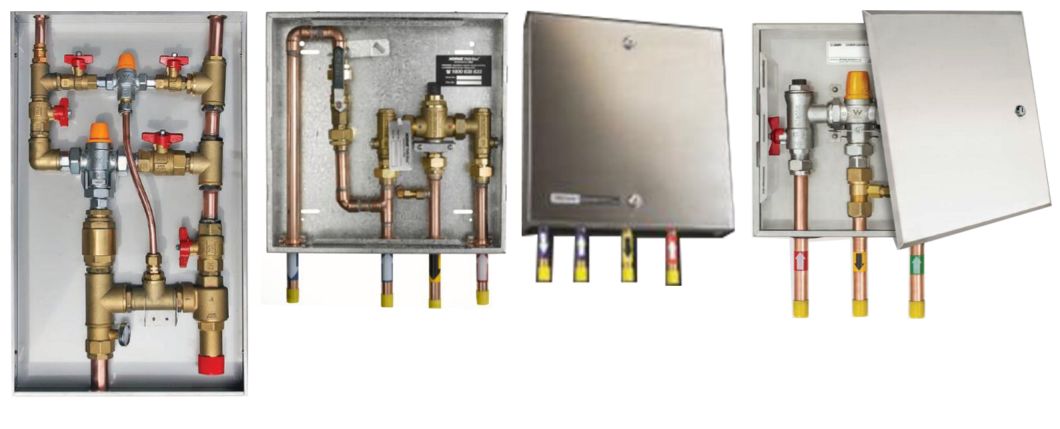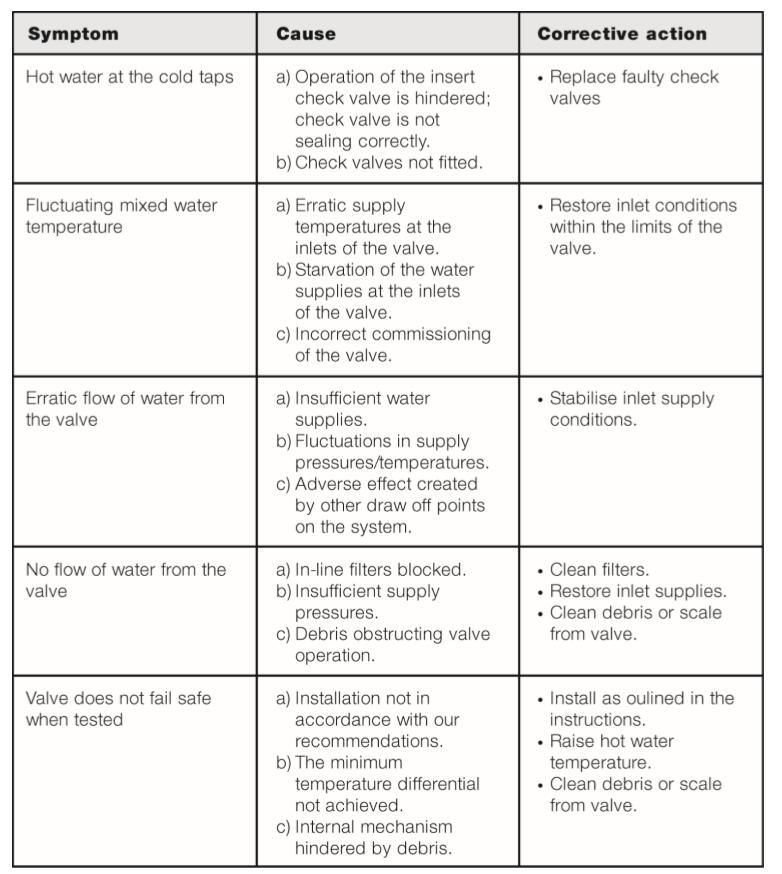Box Cabinet Contain Tmv Thermostatic Mixing Valve for Shower
- TMVs are Watermark approved to AS4032.1 and NSW Health approved.
- Provides tepid warm water at 76 l/min at 210kPa as per AS4775 requirements.
- 15mm valve provides tepid water as low as  2.5l/min if required for use in combination units.
- Union inlets have integrated strainer and check valves.
- Valve will shut off supply upon failure of cold water supply.
- Cold water will bypass the TMV upon failure of hot water supply.
- TMV set temperature can be locked using the locking nut on the adjustment spindle.Â
- Available in SS 70mm deep recessed enclsoure or on a galvanised steel plate.
- Custom configurations.
Â
| Temp Adjustment Range | 30-50ºC |
| Cold Inlet Temperature Range | 5-30ºC |
| Hot Inlet Temperature Range | 55-100ºC |
| Max Working Pressure (static)Â | 1400kPa |
| Minimum Dynamic Pressure | 210kPa |
| Maximum Dynamic Pressure | 600kPa |
| Max Unbalanced Supply Pressure | 6:1 |
| Minimum Flow Rate | 8 l/min |
|
Max Recommended Flow @ 150KPa DP EME30 - eyewash unit EMS90 -  Combo unit  |
30 l/min 90 l/min  |
Advantage
- Simplifies TMV installation on surface or wall recessed and Easily maintained.
- Removable lid with keyed security lock, securely houses and protects each TMV.Â
- Far more precise control over mixed hot water temperature than can be achieved with simple tempering valves.  Â
- Complete Kit Installations.  Â
- Safety first! 1.Quick-react temperature fluctuation feature which controls outlet temperature to +/-2°C.Â
- Â Â Â Â Â Â Â Â Â Â Â 2.Quick Stop Anti-scald featureÂ
           3.Cold shock fail safe featureÂ
           4.Hot temperature fluctuation stability feature.Â
           5.Cold temperature fluctuation stabilityÂ
           6.Quick react pressure featureÂ
           7.Unequal inlet pressures easily controlledÂ
           8.Drips from the valve will be less than 46°C,Â
           9.Dormant period restart safety feature      Â
Â

- Suitable for both indoor and outdoor installation.

Fault Finding in Common

Â
Pulse Solenoid Valve
The pulse signal is input into the coil of the solenoid valve through the wire, and the pulse valve is controlled by the output signal of the pulse injection control instrument. The pressure change of the two gas chambers of the front and back of the valve can make the deformation of the rubber diaphragm open and close the pulse valve. The diameter of the rubber diaphragm determines the size of the rubber diaphragm and the speed of opening and closing. The larger the diameter of the diaphragm, the larger the stroke and the better the injection performance.
Definition:
The pulse solenoid valve is also called the diaphragm valve. It is the "switch" of the compressed air in the dust cleaning and blowing system of the pulse bag type Dust Collector. It is controlled by the output signal of the pulse injection control instrument, and blows the dust in the filter bag (room), so that the resistance of the dust collector is kept within the set range, so as to ensure the handling capacity and the dust collecting efficiency of the dust collector.
Working principle:
The coil of the solenoid valve is input into the forward pulse signal through the wire, and the working flux generated by the coil causes the moving core to pull in and open the valve. When the forward pulse signal is stopped, the moving core is released, the moving core is returned to the initial state under the effect of spring force, and the valve is also kept in the form of self holding, and it can be kept after the forward pulse or power break, and the negative pulse signal is needed to reset. The principle of the pulse solenoid valve is to use the pulse of the electrical apparatus. The impulse is transformed into a mechanical pulsation, which makes the strong energy of the pulsating gas become momentum, and produces a huge force in a short time. The interval of the pulse is controlled by PLC to be determined according to the recovery time of the rated gas pressure, L.
Use:
Usually installed in the main oil road or the shock absorber back pressure oil road, the oil pressure drops when the transmission is automatically raised and lowered, or when the lock stop and the lock stop are started, in order to reduce the shift and lock the unlocking impact and make the vehicle run more balanced.
Its function is to control the oil pressure in the oil road.
Effect:
It is to control the size of oil pressure in the oil road. It is usually installed in the main oil road or the back pressure oil road of the shock absorber to reduce the oil pressure shock when the shift and lock are unlocked, so that the operation of the equipment is kept stable.
According to the angle of valve inlet and outlet and the form of air inlet, it can be divided into three types.
1. right angle electromagnetic pulse valve: the diaphragm valve is directly controlled by electrical signals at the right angle of the inlet and outlet of the valve body.
2. straight through electromagnetic pulse valve: diaphragm valve is directly controlled by electrical signals at 180 degrees of inlet and outlet of valve body.
3. Submerged Electromagnetic Pulse Valve: diaphragm valve which is directly submerged by the valve inlet and is directly controlled by electrical signals.
Pulse Solenoid Valve
Pulse Solenoid Valve,Submerged Electromagnetic Pulse Valve,2 Inch Pulse Solenoid Valve,Rectangular Pulse Solenoid Valve
Botou Youjian Environmental Protection Equipment Co. LTD. , http://www.btdustmachine.com